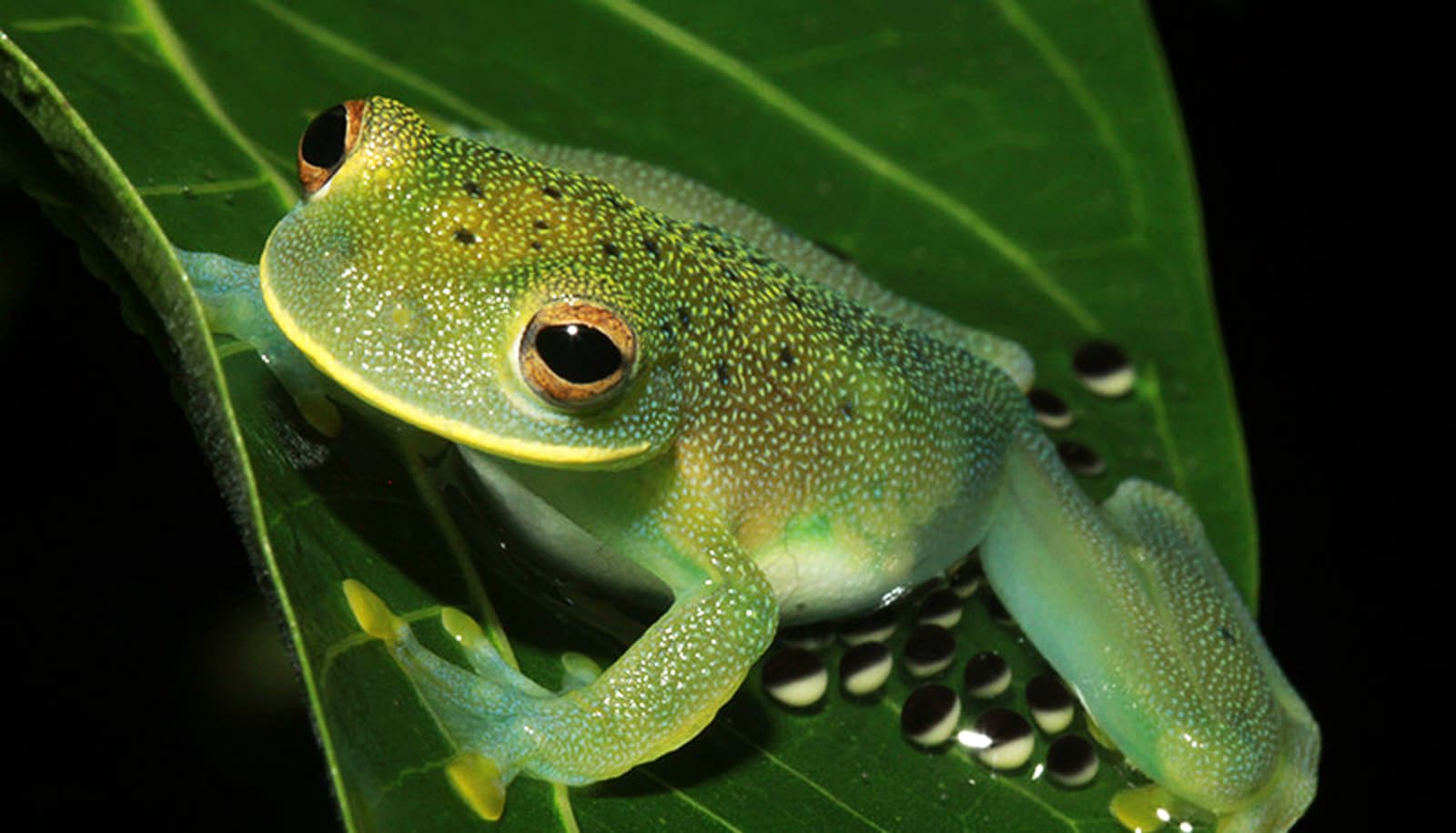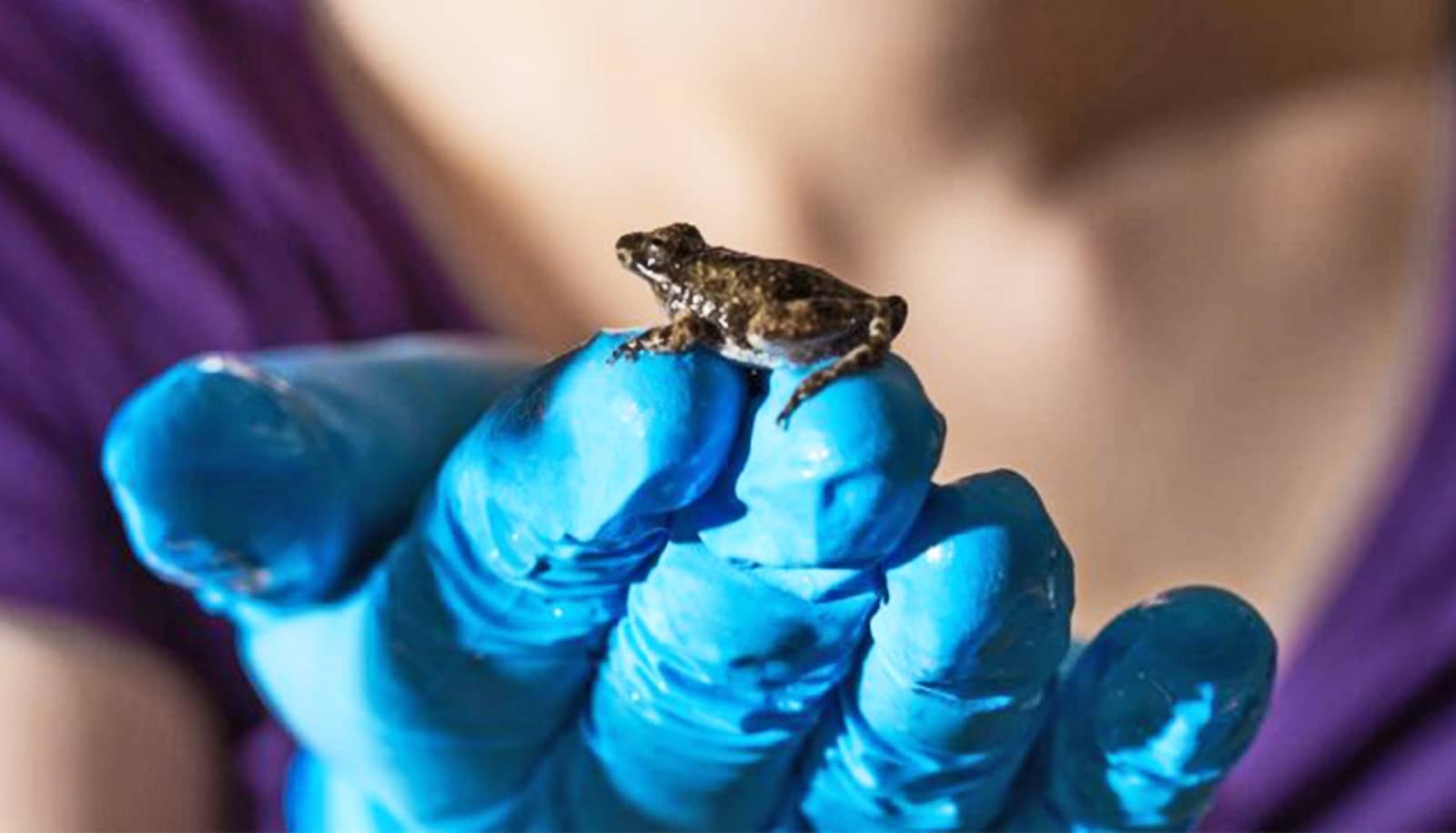Glassfrogs lay their eggs on leaves hanging over streams in tropical rainforests, which makes them tasty snacks for snakes, insects, and other predators. When the survivors hatch, they drop into the streams to begin life as tadpoles.
Until recently, biologists thought the eggs of most species were on their own during this vulnerable stage, without any help from mom or dad. In just a few species, fathers were known to care for their developing embryos, and biologists thought this paternal devotion had evolved from ancestors entirely lacking parental care.
Walking along a stream in Panama very late one night, however, Jesse Delia, a PhD student in the lab of Boston University biology professor Karen Warkentin, spotted a glassfrog mother sitting on her clutch of eggs.
Working with research partner Laura Bravo Valencia, a graduate student at the Universidad de los Andes in Bogotá, Colombia, Delia went on to observe night-time parental behavior among no fewer than 40 species.
The two scientists discovered that in many species, glassfrog mothers brood their eggs during the night the eggs are fertilized, and that this care improves the survival of the eggs, while in almost a third of species, glassfrog fathers stay on guard for much longer periods.
Some frogs mate on land to avoid a ‘breeding frenzy’
Further, in an analysis of glassfrog evolutionary history that takes advantage of the new field data, the investigators discovered that male parental care probably evolved from female care. “Parental care gets elaborate when males take over,” Warkentin says.
These discoveries are based on “a tour de force of extreme fieldwork,” says Warkentin, senior author of the paper in the Journal of Evolutionary Biology. Delia and Bravo Valencia pursued their project over six rainy seasons at 22 sites along streams in Colombia, Ecuador, Mexico, Panama, and Peru. The project also included field monitoring of parental behavior throughout the duration of embryonic development for 13 species—a total of 18 months walking up and down streams every night.
Some of these streams were in warm lowland forests and others up in the Andes mountains. “In Colombia, we would take buses…into the mountains and try to find somebody who would put us up, somewhere close to a forest, a couple hours’ hike into the stream,” says Delia, corresponding author of the study. “Streams in the Andes are really steep, with impassable waterfalls every so often, and in many sites they are cascades of freezing cold water.”
In addition to observing the 40 species of frogs through the night, Delia and Bravo Valencia performed experiments on two species of frogs in Panama. The biologists began by removing glassfrog mothers immediately after the eggs were fertilized, before the mothers could sit on the eggs. Plucking out the frogs in this brief time period often required the researchers to jog up and down the stream, “so we were soaking wet all night,” Delia says.
Protective jelly
Monitoring the eggs daily until they hatched, which could take almost 20 days, showed that the eggs that received maternal care survived significantly better than those that did not.
Salty winter roads may mean fewer female frogs
The key to this survival was that the frogs were soaking up water from damp spots on leaves and delivering it to the eggs. The jelly surrounding the eggs then would swell up with water and grow about four times thicker. Offering these swollen egg packages to katydids, crickets that prey on frog eggs, frustrated the predators, Warkentin says.
“Each embryo is surrounded by this protective layer of jelly, so when the katydid bites, it’s getting mouthfuls of jelly, and it generally gives up.”
Basic fieldwork pays off
Bravo Valencia and Delia also tested what it would take to get glassfrog mothers to abandon their posts in the first few crucial hours. “They would gently poke and pinch and then physically push her off the eggs, and it would take all that to get most moms to leave,” Warkentin says. “The moms are extremely dedicated to their task in that time period.”
“…fathers not only took over the job…but they also greatly elaborated the amount of care.”
“These are relatively well-studied, charismatic frogs, yet we were fundamentally wrong about the reproductive behavior of most glassfrog species,” Warkentin notes. “There is still a lot to be learned from basic fieldwork. And that primary information has the potential to change how we think about larger processes, like sex-role evolution.
“In glassfrogs, maternal care helps embryos survive, but they seem to do the bare minimum,” she says. “It seems that fathers not only took over the job, when mothers were already doing it, but they also greatly elaborated the amount of care. Even after eggs have started hatching, fathers keep caring.”
“In many animals, mothers are on duty when offspring need intensive care, whereas fathers care when it’s easy or help out when more is needed. This common pattern has influenced how we think about parental sex-roles,” Delia says.
“Glassfrogs do the complete opposite—moms do the minimum (at least time-wise) while fathers go to extremes. Of course, glassfrogs are but one small branch on the tree of life. But the way we had underestimated the diversity of parental behavior stresses the importance of getting out to the field and watching animals behave.”
The Smithsonian Tropical Research Institute, the Fulbright Scholar Program, and the National Science Foundation funded the work.
Source: Eric Bender for Boston University



